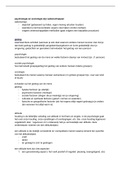Summary
Summary OCR A-level Computer Science Specification & Overview cards for both papers
Contained is a Overview of the Specification and a full deck of flashcards for each paper. They contain all of the basic knowledge needed to complete both papers.
[Show more]








